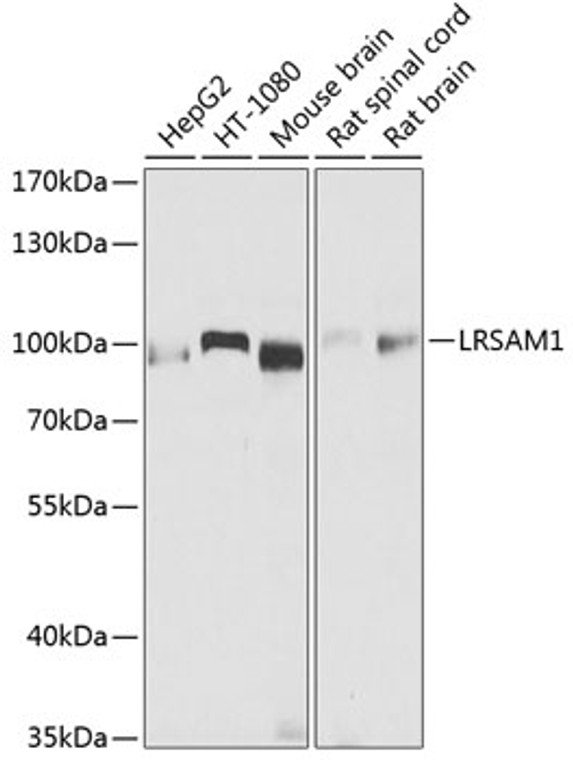| Host: |
Rabbit |
| Applications: |
WB |
| Reactivity: |
Human/Mouse/Rat |
| Note: |
STRICTLY FOR FURTHER SCIENTIFIC RESEARCH USE ONLY (RUO). MUST NOT TO BE USED IN DIAGNOSTIC OR THERAPEUTIC APPLICATIONS. |
| Short Description: |
Rabbit polyclonal antibody anti-LRSAM1 (1-290) is suitable for use in Western Blot research applications. |
| Clonality: |
Polyclonal |
| Conjugation: |
Unconjugated |
| Isotype: |
IgG |
| Formulation: |
PBS with 0.02% Sodium Azide, 50% Glycerol, pH7.3. |
| Purification: |
Affinity purification |
| Dilution Range: |
WB 1:500-1:2000 |
| Storage Instruction: |
Store at-20°C for up to 1 year from the date of receipt, and avoid repeat freeze-thaw cycles. |
| Gene Symbol: |
LRSAM1 |
| Gene ID: |
90678 |
| Uniprot ID: |
LRSM1_HUMAN |
| Immunogen Region: |
1-290 |
| Immunogen: |
Recombinant fusion protein containing a sequence corresponding to amino acids 1-290 of human LRSAM1 (NP_612370.3). |
| Immunogen Sequence: |
MPLFFRKRKPSEEARKRLEY QMCLAKEAGADDILDISKCE LSEIPFGAFATCKVLQKKVL IVHTNHLTSLLPKSCSLLSL ATIKVLDLHDNQLTALPDDL GQLTALQVLNVERNQLMQLP RSIGNLTQLQTLNVKDNKLK ELPDTVGELRSLRTLNISGN EIQRLPQMLAHVRTLEMLSL DASAMVYPPREVCGAGTAAI LQFLCKESGLEYYPPSQYLL PILEQDGIENSRDSPDGPT |
| Tissue Specificity | Highly expressed in adult spinal cord motoneurons as well as in fetal spinal cord and muscle tissue. |
| Post Translational Modifications | Ubiquitination promoted by PHF23 leads to proteasomal degradation. |
| Function | E3 ubiquitin-protein ligase that mediates monoubiquitination of TSG101 at multiple sites, leading to inactivate the ability of TSG101 to sort endocytic (EGF receptors) and exocytic (HIV-1 viral proteins) cargos. Bacterial recognition protein that defends the cytoplasm from invasive pathogens. Localizes to several intracellular bacterial pathogens and generates the bacteria-associated ubiquitin signal leading to autophagy-mediated intracellular bacteria degradation (xenophagy). |
| Protein Name | E3 Ubiquitin-Protein Ligase Lrsam1Leucine-Rich Repeat And Sterile Alpha Motif-Containing Protein 1Ring-Type E3 Ubiquitin Transferase Lrsam1Tsg101-Associated LigaseHtal |
| Database Links | Reactome: R-HSA-983168 |
| Cellular Localisation | CytoplasmDisplays A Punctuate Distribution And Localizes To A Submembranal RingLocalizes To Intracellular Bacterial Pathogens |
| Alternative Antibody Names | Anti-E3 Ubiquitin-Protein Ligase Lrsam1 antibodyAnti-Leucine-Rich Repeat And Sterile Alpha Motif-Containing Protein 1 antibodyAnti-Ring-Type E3 Ubiquitin Transferase Lrsam1 antibodyAnti-Tsg101-Associated Ligase antibodyAnti-Htal antibodyAnti-LRSAM1 antibodyAnti-TAL antibodyAnti-UNQ6496 antibodyAnti-PRO21356 antibody |
Information sourced from Uniprot.org
12 months for antibodies. 6 months for ELISA Kits. Please see website T&Cs for further guidance








![Western blot analysis of lysates from wild type (WT) and MSH6 knockout (KO) HeLa cells, using [KO Validated] MSH6 Rabbit polyclonal antibody (STJ119980) at 1:500 dilution. Secondary antibody: HRP Goat Anti-Rabbit IgG (H+L) (STJS000856) at 1:10000 dilution. Lysates/proteins: 25 Mu g per lane. Blocking buffer: 3% nonfat dry milk in TBST. Detection: ECL Basic Kit. Exposure time: 1min. Western blot analysis of lysates from wild type (WT) and MSH6 knockout (KO) HeLa cells, using [KO Validated] MSH6 Rabbit polyclonal antibody (STJ119980) at 1:500 dilution. Secondary antibody: HRP Goat Anti-Rabbit IgG (H+L) (STJS000856) at 1:10000 dilution. Lysates/proteins: 25 Mu g per lane. Blocking buffer: 3% nonfat dry milk in TBST. Detection: ECL Basic Kit. Exposure time: 1min.](https://cdn11.bigcommerce.com/s-zso2xnchw9/images/stencil/300x300/products/98765/382817/STJ119980_1__09948.1713151312.jpg?c=1)